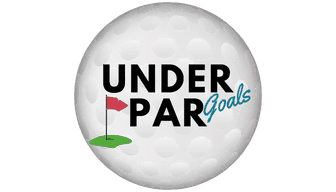Not hitting the center of the club face shouldn’t stop you from enjoying the game. But if you want some help getting the ball headed in the right direction, then you’ll need to pick the right irons.
My pick for the best game improvement irons are the Callaway Rogue ST MAX Irons because they have the perfect combination of game helping technology and control to help you get better.
But if you want my full breakdown and see my other picks that might fit your specific needs even better, then keep reading…
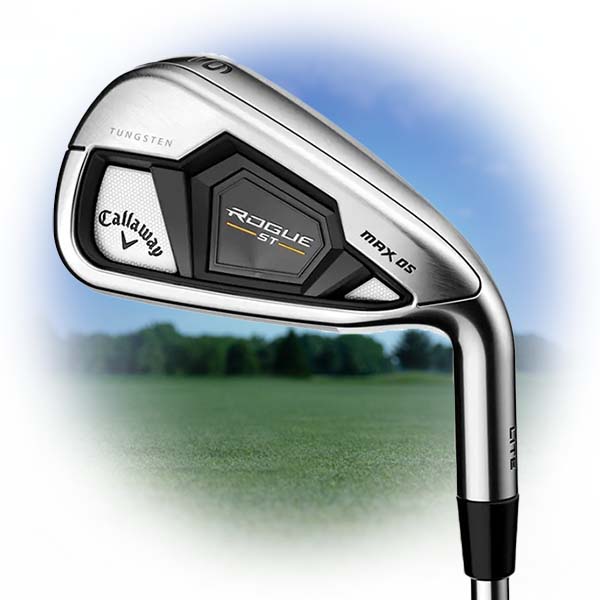
1. Callaway Rogue ST MAX OS
The clubs for golfers searching for answers in every part of their game. Never before has it been easier to improve in multiple areas at once than with the Rogue ST Max OS Lite irons.
Whether you’ve been a high handicapper for some time or are just picking up the game, one of the most important things to understand is that the clubs the pros use are not for you.
So don’t worry of you don’t see PGA Tour pros using these irons, because they’re designed to get the ball to it’s target even when you don’t hit it all that well.
Callaway Rogue ST MAX OS Specs
- Lofts: 7-iron: 28.5°, Pitching Wedge: 41°
- Lofts Available: 4 (20°) through SW (56°)
- Offset: 7-iron: 6.6mm, Pitching Wedge: 4.7mm
- Head Shape/Size: Oversized
- Launch: High
- Stock Shafts:
- Mitsubishi Tensei AV Blue 65 HB/IR Graphite
- Mitsubishi Tensei AV Blue 75 HB/IR Graphite
- Project X Cypher Black 50 HB/IR Graphite
- True Temper Elevate MPH 85 Steel
Then, add in the updated internal weighting system (46 grams of tungsten) that shifts the center of gravity to aid launch angle.
This moves the center of gravity lower in the club making it easier to get the ball up in the air and increase carry distance. This also means that you’ll see a higher flight which helps stop the ball on the greens even if you aren’t spinning it like a pro.
Pros
Cons
Very forgiving and easy to make contact.
Increased distance on all shots
A bit of a chunky design may not appeal to purists.
And let’s talk about contact and how these clubs make life easier. For ground-turf interaction, a wide sole deters most chunks as the club does not dig into the ground as easily.
As you make your contact, a fair amount of offset (the OS in the club name) helps to correct the spin on the ball and promotes straight flight.
These are the clubs I would recommend to anyone that needs a little help with their game.
On top of that, they can often be found a few hundred dollars cheaper than most of the latest iron sets (check the links above).
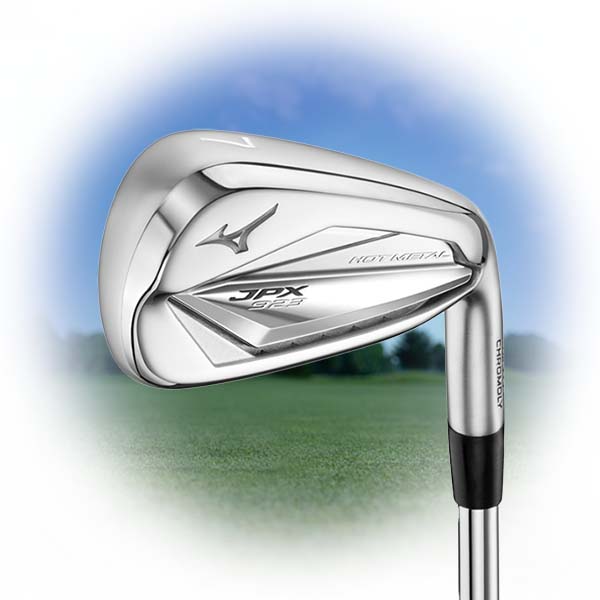
2. Mizuno JPX 923 Hot Metal HL Irons
Game improvement irons for players that are actively working on improving their swing too.
If forgiveness is your biggest concern, Mizuno JPX 923 Hot Metal HL irons should be near the top of your list. This line of clubs is not new, but with each yearly update, Mizuno makes them more appealing to the mid and high handicap population.
Mizuno JPX 923 Hot Metal HL Iron Specs
- Lofts: 7-iron: 31°, Pitching Wedge: 45°
- Lofts Available: 4 (19°) through LW (60°)
- Offset: 7-iron: 0.196mm, Pitching Wedge: 0.35mm
- Head Shape/Size: Oversized
- Launch: High
- Stock Shafts: Aerotech SteelFiber i110 Graphite
One of the most innovative ways our runner-up pick offers forgiveness is a uniquely designed sole. Most options for high handicappers will just beef the sole up. This method is effective but has some drawbacks.
Mizuno takes a different approach and instead widened the thinner parts of the sole. By focusing only on the areas most in need, the Hot Metal HL irons are effective in reducing the ill effects of shots off the toe and heel. The changes to the sole also create a wider sweet spot.
Pros
Cons
Excellent ball speed off the face.
A forgiving face, especially on shots towards the top of the face.
These clubs may be too flexible for fast swinging players.
Essentially, your bad shots aren’t as bad. And your good shots are even better.
A very underappreciated part of these clubs is the color. Featuring a non-reflective outer coating, playing in the early morning or at twilight when the sun is low will not leave you blinded from the light reflecting off your club.
For many high handicappers who prefer to play when the course is less crowded, this is worth a few bonus points.
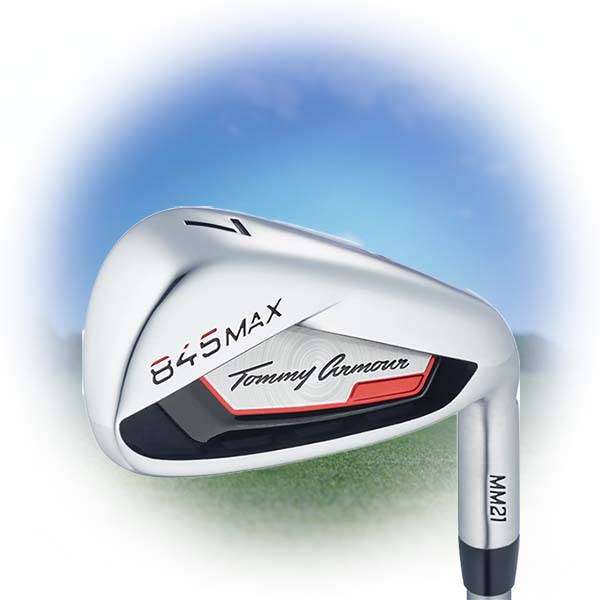
3. Tommy Armour 2021 845-MAX
Whether you’re seeking a starter set as you test the waters that are golf or are looking for big improvements at the lowest cost possible, Tommy Armour 845-Max irons will get the job done.
Once a top name in golf, Tommy Armour is experiencing a resurgence under the Dick’s Sporting Goods umbrella. Fittingly enough, their top model shares the same name as their once incredibly popular model, the 845.
Tommy Armour 2021 845-MAX Specs
- Lofts: 7-iron: 31°, Pitching Wedge: 45°
- Lofts Available: 5 (24°) through AW (50°)
- Head Shape/Size: Oversized
- Launch: High
- Stock Shafts:
- SL85 Steel
- UST Mayima Recoil 660 SC Graphite
The best budget option for high handicap players is the Tommy Armour 845-Max iron set. At a fraction the cost of other name brands, the 845-Max’s are quality clubs designed for players looking to improve carry distance.
By designing the hosel and back of the club to lower the center of gravity and improve MOI, the thing you will notice first is how high you hit the ball. And this includes when you do not hit the ball on the center of the face. These same design features also help you square the clubface at impact and straighten your shots out.
Pros
Cons
Lightweight shafts and clubheads will help you improve your swing speed.
“Pre-worn” front edges bounce off the turf rather than dig into them.
Less distance than other super game improvement clubs.
Large offset can hurt if you tend to draw the ball
And unlike other brands you might find online offering clubs are prices almost too good to be true, Dicks utilizes good materials and the high quality designs they came into when the Tommy Armour brand was acquired. If you’re unsure about the brand, ask someone at your local golf course. They’ll know Tommy Armour and may have even had a set at one point. Then ask them about the other brands offering iron sets at this price. There won’t be much to go on with them.

4. Cobra T-Rail Combo Irons
Designed for golfers who struggle the most with consistent contact, this unique design is sure to offer a major boost.
You may have never seen a set of clubs that look like the Cobra T-Rail set. You might not see another one on the shelves of any golf store either. That does not mean you should not look into them.
Cobra T-Rail Combo Irons Specs
- Lofts: 7-iron: 29°, Pitching Wedge: 44°
- Lofts Available: 4 hybrid (20°) through SW (56°)
- Offset: 7-iron: 3.0mm, Pitching Wedge: 1.8mm
- Head Shape/Size: Oversized
- Launch: High
- Stock Shafts:
- COBRA Ultralite 50
- COBRA Ultralite 45
For a high handicapper, you need practical clubs that make getting around the golf course easier. That’s exactly what the Cobra T-Rail combo set is.
With each club bordering on the look and feel of a hybrid, getting through the rough, elevating the ball, and good contact will all become easier.
Pros
Cons
Consistent head shape is easy to get comfortable with when looking down over the ball.
Each club is easy to hit off the tee. A nice benefit when playing par 3’s.
Golfers with slow swing speeds will struggle to get the heads through thick rough.
Depending on your golf history knowledge, you may not know the hybrid is a more recent innovation. Hybrids are a substitute for long irons and are much easier to hit. This innovation made it so less skilled ball strikers could hit it farther with greater consistency. The same principle applies here. By using the same methods that make it easier for skilled golfers to hit clubs they struggle with, T-Rail clubs do the same with all clubs.
A hollow design and oversized head lets you get faster without fear of as extreme mishits. Whether you’re making contact off the toe, heel, or center, the ball will take similar flight. Additionally, the hollow head and hybrid-like face will offer distance benefits as having more room allows Cobra to optimize the surface in the areas high handicap golfers need the most help.
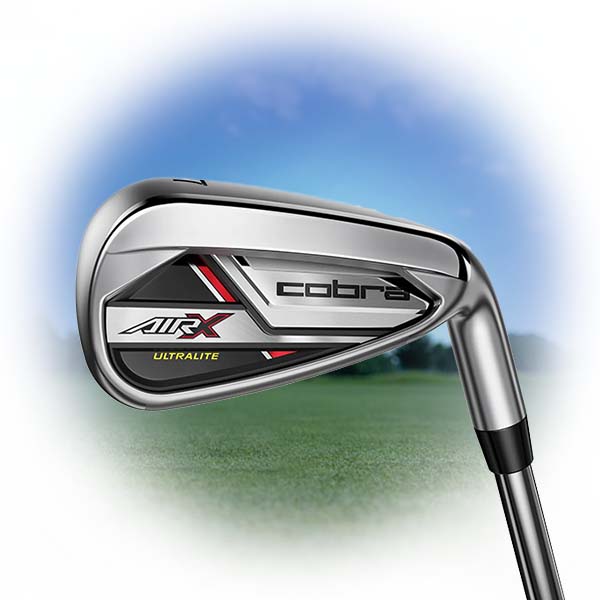
5. Cobra AIR-X Irons
AIR-X irons are designed for you to hit it high with a nice draw shape…and those are the looks we’re really going for.
Admittedly, we know the Cobra T-Rail’s won’t be for everyone. Looks and sound are some of the top considerations for people, even if their performance will suffer. Sometimes, in rare cases, there are clubs that embody the Deion Sanders “look good, feel good, play good” mantra people love.
In club form for high handicappers, that is the Cobra AIR-X iron set. With the appearance of a players performance iron and the technology of a super game improvement iron, everyone wins.
Cobra AIR-X Iron Specs
- Lofts: 7-iron: 30°, Pitching Wedge: 43.5°
- Lofts Available: 4i (21°) through SW (55°)
- Offset: 7-iron: 5.1mm, Pitching Wedge: 3.1mm
- Head Shape/Size: Oversized
- Launch: High
- Stock Shafts:
- COBRA FST Ultrailite Steel
- COBRA Ultralite 50
While we had many options for this category, the place where AIR-X irons separated themselves was their weight and encouragement of controlled speed.
Lightweight materials speak for themselves. It’s natural you can swing these clubs faster. But it’s the control piece that really works for high handicappers.
Through heel weighting and a noticeable offset, hitting it straight becomes a secondary concern and allows you to focus on improving in other areas. Added weight to the heel helps close the face as you strike the ball on its own.
Pros
Cons
Best when struck in the middle or top half of the clubface.
Grips, shaft, head – all lightweight to help build speed.
Slice prevention design works against golfers who already hit it straight.
Add in an offset face to make sure you begin with a square face and the two features easily work together for a noticeable difference.
Using AIR-X irons won’t make it obvious you’re using super game-improvement irons and neither will your play on the course.
Clubs to Avoid
While these aren’t necessarily bad clubs, I wanted to share some irons sets that I’ve seen recommended for high handicappers elsewhere that really don’t fit your needs.
Titleist T400
While the T400 might Titleist’s most forgiving iron, it fails high handicap players by not being forgiving enough for those with low swing speeds.
Additionally, the boost provided for launch and control is average in both categories. For a high handicapper, you should be looking for a club that provides a substantial boost in one of those areas, depending on your own game.
The final thing that stands out about this club when compared to the other best irons for high handicappers is price. For a players performance club, the T400 falls right in line. But there are far more affordable options when compared to other clubs for golfers shooting 110+.
This club is best for a mid-handicap golfer whose issue is control, not speed. If you’re a golfer in that position, the T400 should be at the top of your list.
TaylorMade Stealth
For a high handicapper, TaylorMade Stealth irons are bound to come up in your search for new clubs. They would be an easy purchase to make because of the brand power and their popularity too. But that doesn’t make them a top option.
The Stealth is regarded as a game improvement iron and even that is up for debate. For a high handicap golfer who struggles with consistent contact, your problems will be amplified. The sole of this club is built more like a players iron than anything else and will affect your distance and direction.
Don’t be duped by the number your peers with these in their bags. Even within the brand there are better options for those struggling with distance, swing speed, control, or launch.
Callaway Paradym Ai Smoke
Another great club, just not for high handicappers. With the Paradym Ai Smoke, Callaway succeeding in creating an option below their players iron (Paradym) that can be used by a bigger chunk of golfers. However, it is still geared towards mid-handicappers and high single digit handicappers with control issues.
Adding the Ai Smoke HL and Ai Smoke Max Fast to the lineup was a step in the right direction.
But it failed to create a true option for beginners or people who struggle with getting the ball in the air.
Across the Paradym Ai Smoke board, forgiveness is at the proper level for high handicap golfers.
However, it isn’t enough for us to include any of these clubs as one of our top picks. If you are really interested in Callaway or find yourself teetering on the edge of high and mid-handicap, Callaway Paradym Ai Smoke Max Fast is where you should direct your energy.
What Are Game Improvement Irons?
Game improvement irons are specifically so that when the ball is hit slightly off-center, the negative effects are not as severe. Additionally, GI irons make it so that those terrible shots aren’t so terrible.
To accomplish this, golf club manufacturers have found ways to spread weight evenly across the club face. Essentially proper weight distribution enlarges the sweet spot. The rationale behind this is that golfers using game improvement clubs also need a bit more help finding the center of the club. An increased likelihood of connecting at the sweet spot means straighter and longer shots.
Expanding a little bit on weight distribution, game improvement irons can often be identified by their “cavity back.” The weight of their counterpart, blade irons, is concentrated on the center. Because of this they have a small, but powerful sweet spot. For mid and high-handicap golfers, hitting each shot perfectly square is unrealistic and the exact reason why game improvement irons exist. This doubles for shots from the rough.
Larger flanges and club heads on GI irons provide an opportunity for club designers to add some aesthetic flair. For one, the larger head size inspires confidence. Secondly, doesn’t prefer a good-looking club to something less appealing?
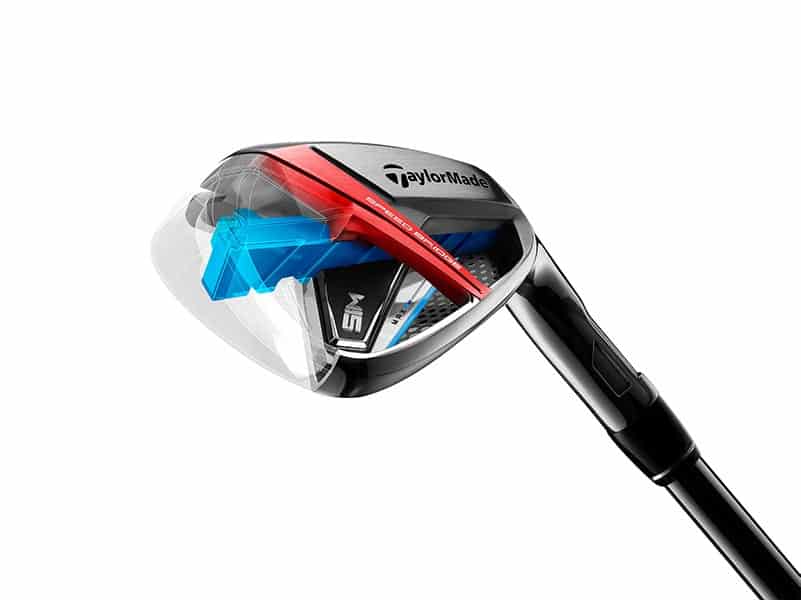
Who Should Use Game Improvement Irons?
If you’re a scratch golfer (or even a single digit handicap), chances are that your ball striking is so accurate and consistent you do not need the extra assistance provided by game improvement irons. For everyone else, you’re going to want to go ahead and take any help you can get. To narrow things down, GI irons are best suited for players with handicaps from 12-25, but that range is certainly fluid.
When you’re at the point in your golf career where you regularly make solid, but not perfect contact on every swing, game improvement irons are something you should be interested in. GI irons are designed to promote consistency in terms of accuracy and distance. If you’ve ever been out playing with your buddies and gotten the “you really got ahold of that one” compliment, you probably want to be able to make that type of contact with each swing. Game improvement irons are not a final solution, but help quite a bit.
Game improvement irons are also a logical next step from golfers who have graduated from beginner box sets and want to invest in equipment to continue improving. With the right irons, it could be enough to get from 100 to 90, or 90 to 80.
What to Look for When Choosing Game Improvement Irons
Forgiveness
Game improvement implies that there are aspects of your game you acknowledge need to be improved. It also means you make plenty of mistakes on the course. To help yourself out, you’re going to want to find a set of clubs as forgiving as possible.
At this point in your golf “career” solid contact is not as big of an obstacle as it once was, but accuracy is more challenging. With a forgiving set of clubs, smaller mistakes are neutralized and bad swings won’t lead to catastrophic results.
Progression of Help
If you started playing with a box set, or use an older set of clubs, you are not taking advantage of the technical advances of recent years. Don’t get me wrong, in order to get the best set of clubs for your game you will have to spend some money. Game improvement irons are far from the most expensive clubs on the market, but compared to the lowest-budget clubs can be costly.
When you spend a little extra money, you are essentially getting custom clubs designed for a player of your caliber and in need of a boost. The right game improvement clubs will have varying designs for long and short irons. Having clubs that are not all made from the same mold means that each iron has been specifically designed for the type of shot you typically hit with it. This also doubles as the design being focused to eliminate general obstacles such as getting long irons off the ground or a lack of control with short irons.
Added Distance and Control
The best game improvement irons will help you add distance AND control. Being able to gain one without the other is nice, but often times improving one of these comes at the expense of the other. If you can add both of them together, your scores get lower—case closed.
When you’re able to add even just a little bit of distance and control, it has a snowball effect on your game. Instead of hitting a 7 iron, you can hit an 8. Rather than having to lay up, because of distance or a tight landing area, you can take a controlled risk that lets you pull out your putter instead a wedge. This is usually accomplished with a flexible club face and an even weight distribution that leads to an expanded sweet spot range.
Common Questions
Should I get steel or graphite shafts on my game improvement irons?
Unpopular answer, but shaft choice boils down to personal preference. In general, steel shafts are associated with more skilled players, and graphite is seen as more for beginners.
Graphite shafts are more expensive and lighter than steel shafts. With the lighter weight, your swing speed is faster, and in turn, distance is increased. Steel shafts are more responsive and provide better feedback on the contact you’ve made.
In terms of durability, steel shafts are less likely to break than graphite shafts. Most players with faster swing speeds prefer steel shafts because they are better suited to support their up-tempo game.
Should I get game improvement or super game improvement irons?
The question above can also be phrased, as “Do I need some help?” or “Do I need a lot of help?” After some self-reflection, you should be able to determine if you can get by with game-improvement irons, or if you need super game-improvement irons.
Game improvement irons have smaller cavities than super game improvement irons. The slimmer club face makes it easier to cut through the air and increase swing speed. Super game improvement irons have larger club faces and are designed to further reduce the negative effects of poor contact and low swing speed.
Why don’t pros use game improvement irons?
Professional golfers prefer to not use game improvement irons because it is more difficult to shape shots and alter ball flight than with blades. While it is not impossible to draw, cut and fade GI irons, club design makes it harder to do so as dramatically.
Since pros don’t usually hit straight shots, they prefer having the capacity to bend shots as they please. Most of their decision to not hit a shot straight is based on placement for the next shot.
A growing trend, however, is for pros to use a split set. For their long irons, they use game improvement clubs, but blades for the rest.
Can pros use game improvement irons?
Long story short, yes. While they probably aren’t playing the exact same clubs as you (shafts are important), pro golfers often fill their bags with a variety of clubs, some of which fall under the game improvement category.
When he’s not winning Blake of the Year, Brooks Koepka is busy winning golf tournaments. Brooks plays Mizuno JPX 919 Tour irons, a variation of the very same JPX 919’s you’re seeing in our guide today.
Until mid-2019, Jordan Spieth always carried Titleist AP2 irons. Last year he made the switch to Titleist T100’s. Although his replacements are not blades, the AP2’s fit more comfortably in the game improvement category.
